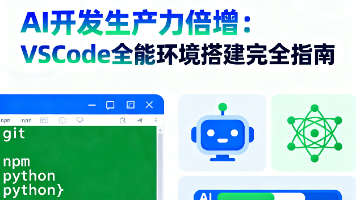Flutter 组件详解:Container
特性说明功能集成一个组件集成背景、边框、圆角、内边距、外边距、对齐、变换等多种功能。灵活组合通过属性组合实现复杂 UI(如带阴影的圆角卡片)。布局友好支持尺寸控制(widthheight)和约束(),适配不同场景。视觉增强通过decoration实现渐变、阴影、边框等高级效果。万能容器既可以承载子组件,也可以作为无内容的占位符或装饰层。🎯一句话总结Container是 Flutter 中“最懂布
Flutter 组件详解:Container —— 最灵活的“万能容器”
在 Flutter 开发中,Container 是最基础、最常用,同时也是最灵活的布局组件之一。它本质上是一个组合型组件,内部集成了多种功能(如背景色、边框、圆角、内边距、外边距、对齐、变换等),可以通过简单的配置快速实现复杂的 UI 效果,被开发者称为“万金油”组件。
一、Container 的核心定位
1. 是什么?
Container是一个用于承载子组件(Widget)并为其添加装饰性效果和布局约束的容器组件。它本身不直接显示内容(除非通过 child设置子组件),而是通过一系列属性为子组件提供“容器化”的能力。
2. 有什么用?
- 为子组件添加背景色、边框、圆角等视觉样式。
- 控制子组件的位置(通过
alignment或margin/padding)。 - 限制子组件的尺寸(通过
width/height或约束)。 - 组合多种效果(如背景 + 边框 + 圆角 + 阴影)。
- 作为布局中的“占位符”或“装饰层”。
🎯 简单理解:如果把 UI 比作搭积木,
Container就像是一个“带装饰的盒子”,你可以往里面放其他积木(子组件),同时给这个盒子涂颜色、加边框、调整位置。
二、Container 的基本结构与核心属性
1. 基本语法
Container({
Key? key,
this.alignment, // 子组件对齐方式(Alignment)
this.padding, // 内边距(EdgeInsets,作用于子组件周围)
Color? color, // 背景色(简写,优先级低于 decoration)
Decoration? decoration, // 背景装饰(如 BoxDecoration,包含颜色、边框、圆角等)
Decoration? foregroundDecoration, // 前景装饰(覆盖在子组件上方,较少用)
double? width, // 容器宽度(可选)
double? height, // 容器高度(可选)
BoxConstraints? constraints, // 更灵活的尺寸约束(覆盖 width/height)
this.margin, // 外边距(EdgeInsets,作用于容器与其他组件的间距)
this.transform, // 几何变换(如旋转、缩放,Matrix4)
this.child, // 子组件(必需的视觉内容)
})
⚠️ 注意:
Container的子组件(child)是可选的。如果没有子组件,Container会尝试根据父级约束调整自身尺寸(例如通过width/height或alignment)。
2. 核心属性分类详解
(1)子组件相关:child
-
作用:
Container的核心是承载一个子组件(如Text、Image、Icon等)。
示例:
Container(
child: Text('Hello Container'),
)
(2)尺寸控制:width/ height/ constraints
width和 height:直接指定容器的固定宽高(单位:逻辑像素)。
Container(
width: 200,
height: 100,
color: Colors.blue,
child: Text('固定尺寸 200x100'),
)
constraints:通过 BoxConstraints更灵活地控制最小/最大宽高(优先级高于 width/height)。
Container(
constraints: BoxConstraints(
minWidth: 100,
maxWidth: 300,
minHeight: 50,
maxHeight: 150,
),
child: Text('动态约束尺寸'),
)
📌 优先级规则:
constraints>width/height(如果同时设置,constraints会覆盖固定值)。
(3)背景与装饰:color与 decoration
color:直接设置容器的背景颜色(简单场景使用)。
Container(
color: Colors.red, // 背景色为红色
child: Text('红色背景'),
)
⚠️ 注意:如果同时设置了
decoration,则color会失效!因为decoration是更通用的装饰属性(包含颜色、边框、圆角等)。
decoration:通过 BoxDecoration实现更复杂的背景效果(推荐复杂场景使用)。
Container(
decoration: BoxDecoration(
color: Colors.blue, // 背景色
borderRadius: BorderRadius.circular(10), // 圆角
border: Border.all( // 边框
color: Colors.black,
width: 2,
),
boxShadow: [ // 阴影
BoxShadow(
color: Colors.grey.withOpacity(0.5),
spreadRadius: 2,
blurRadius: 5,
offset: Offset(0, 3),
),
],
),
child: Text('带圆角、边框和阴影的容器'),
)
BoxDecoration常用属性:
color: 背景色(与color属性二选一)。borderRadius: 圆角半径(BorderRadius.circular(10)表示 10 逻辑像素的圆角)。border: 边框(通过Border.all()设置统一边框,或Border()分别设置四边)。boxShadow: 阴影列表(通过BoxShadow定义颜色、模糊半径、偏移等)。gradient: 渐变背景(如线性渐变LinearGradient)。
(4)内外边距:padding与 margin
padding:设置子组件与容器边缘的内边距(即子组件周围的空白区域,属于容器内部)。
Container(
padding: EdgeInsets.all(20), // 四周内边距 20
color: Colors.yellow,
child: Text('内边距 20'),
)
EdgeInsets常用构造函数:
-
all(20): 四周统一 20。 -
symmetric(horizontal: 10, vertical: 20): 水平 10,垂直 20。 -
fromLTRB(左, 上, 右, 下): 分别指定四边。
margin:设置容器与其他组件之间的外边距(即容器周围的空白区域,属于布局外部)。
Container(
margin: EdgeInsets.all(30), // 容器四周外边距 30
color: Colors.green,
child: Text('外边距 30'),
)
🎯 区别:
padding是“容器内部的空间”,margin是“容器与其他组件之间的空间”。
(5)对齐方式:alignment
-
作用:当子组件的尺寸小于容器尺寸时,控制子组件在容器内的对齐位置(类似“居中”“靠左”等)。
常用值:通过 Alignment枚举设置(如 Alignment.center、Alignment.topLeft)。
Container(
width: 200,
height: 200,
color: Colors.grey,
alignment: Alignment.center, // 子组件居中
child: Container(
width: 50,
height: 50,
color: Colors.red,
),
)
Alignment常用值:
Alignment.center:居中(默认值)。Alignment.topLeft:左上角。Alignment.bottomRight:右下角。Alignment(0.5, 0.5):自定义坐标(范围 -1~1,(0,0) 是中心)。
(6)变换:transform
-
作用:对整个容器(包括子组件)应用几何变换(如旋转、缩放、平移),不影响布局但改变最终显示效果。
常用方式:通过 Matrix4或快捷方法(如 Transform组件,但 Container自身也支持)。
Container(
transform: Matrix4.rotationZ(math.pi / 4), // 旋转 45°(弧度)
color: Colors.blue.withOpacity(0.3),
child: Text('旋转 45°'),
)
📌 注意:
transform不会改变容器的实际占用空间(布局时仍按原始尺寸计算)。
三、Container 的常见使用场景
1. 基础样式容器(背景 + 圆角 + 内边距)
Container(
padding: EdgeInsets.all(16),
decoration: BoxDecoration(
color: Colors.white,
borderRadius: BorderRadius.circular(8),
boxShadow: [
BoxShadow(color: Colors.grey.shade300, blurRadius: 4, offset: Offset(0, 2)),
],
),
child: Text(
'这是一个带圆角、阴影和内边距的卡片',
style: TextStyle(fontSize: 16),
),
)
效果:白色背景、圆角 8、阴影、文字居中(默认)。
2. 居中显示一个图标或按钮
Container(
width: 100,
height: 100,
color: Colors.blue.withOpacity(0.1),
alignment: Alignment.center, // 子组件居中
child: Icon(Icons.star, color: Colors.orange, size: 40),
)
效果:100x100 的半透明蓝色容器,内部的星星图标居中显示。
3. 带边框和间距的列表项
Container(
margin: EdgeInsets.symmetric(vertical: 8), // 上下外边距 8
padding: EdgeInsets.symmetric(horizontal: 16, vertical: 12),
decoration: BoxDecoration(
color: Colors.white,
border: Border(bottom: BorderSide(color: Colors.grey.shade300, width: 1)),
),
child: Text('列表项内容'),
)
效果:列表项之间有分隔线和上下间距。
4. 无子组件的占位容器(如间隔、装饰块)
Container(
width: 50,
height: 50,
color: Colors.transparent, // 透明背景
// 无 child,仅作为布局中的占位或装饰
)
四、Container 的注意事项
1. color与 decoration的互斥
-
规则:如果同时设置了
color和decoration,color会失效!因为decoration是更通用的装饰属性(包含颜色、边框、圆角等)。
正确做法:如果需要背景色 + 其他装饰(如边框、圆角),将颜色放在 decoration的 color字段中:
Container(
decoration: BoxDecoration(
color: Colors.blue, // 背景色放在这里
borderRadius: BorderRadius.circular(10),
),
child: Text('正确用法'),
)
2. 尺寸控制的优先级
- 如果未设置
width/height,Container会尝试根据子组件和父级约束自动调整尺寸。 - 如果设置了
width/height,但父级约束不允许(例如父级是Column且无固定高度),可能会导致布局错误(如溢出)。此时建议用constraints或Expanded/Flexible辅助。
3. 无子组件的 Container
- 如果
Container没有子组件(child为 null),它会尝试根据父级约束调整自身尺寸(例如通过width/height),或者成为一个“不可见占位符”。
五、总结:Container 的核心优势
| 特性 | 说明 |
|---|---|
| 功能集成 | 一个组件集成背景、边框、圆角、内边距、外边距、对齐、变换等多种功能。 |
| 灵活组合 | 通过属性组合实现复杂 UI(如带阴影的圆角卡片)。 |
| 布局友好 | 支持尺寸控制(width/height)和约束(constraints),适配不同场景。 |
| 视觉增强 | 通过 decoration实现渐变、阴影、边框等高级效果。 |
| 万能容器 | 既可以承载子组件,也可以作为无内容的占位符或装饰层。 |
🎯 一句话总结:
Container是 Flutter 中“最懂布局的装饰盒”,适合快速实现带样式的组件容器,是日常开发中最常用的“瑞士军刀”组件。
更多推荐
 已为社区贡献2条内容
已为社区贡献2条内容








所有评论(0)